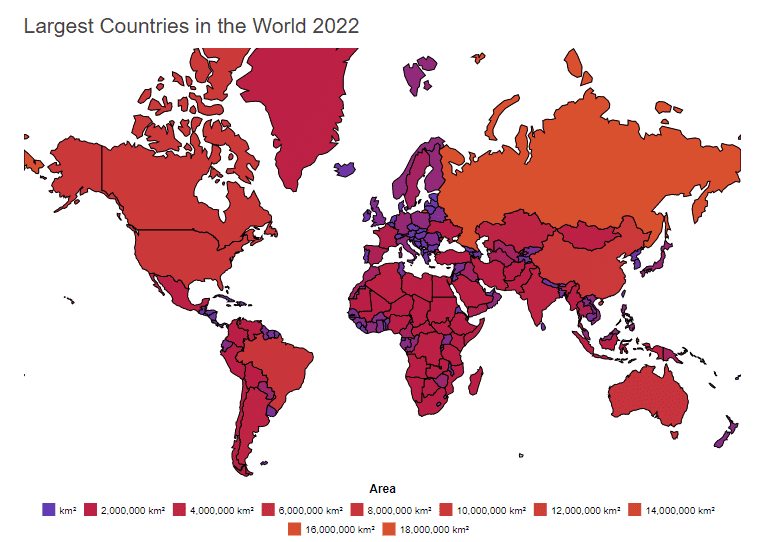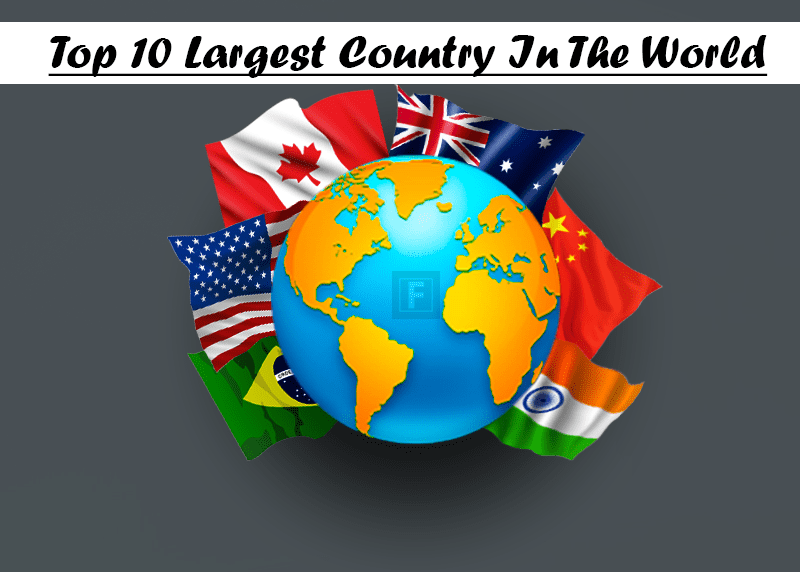The earth comprises many different countries, some of which are real giants that occupy enormous areas and span continents. While most of us are familiar with the top 10 largest countries in the world, it’s still interesting to know what makes them so big. This article will explore each of the top 10 largest countries and their size and population.
Which is the largest country in the world?
The world’s size is a common topic of conversation, and countries vary widely in size. The smallest countries are only a couple of square miles across, while the largest countries cover millions of square kilometres. Below are the largest countries in the world in order of total area and population. Russia is in first place, then Canada, China, the United States, Brazil, Australia, India, Argentina, Kazakhstan, and Algeria.

#1 Russia
If you are looking for the world’s largest country, Russia is the place to be. The country covers an area of 17.1 million square kilometres, or almost twice as large as Canada. It shares borders with more than a dozen nations and is the only nation in the world to occupy an entire continent. The number of UNESCO World Heritage Sites is also high, with more than 30 sites in the country.
Note: Have you ever thought about making money while you are sleeping? Check this out!
It is also the largest-inhabited country, with a population of 144.1 million. In comparison, China has a population of 1.4 billion and makes up 19% of the world’s population. The country’s population has grown a lot over the years, though, as its territory has shifted due to migration and industrialization.
#2 Canada
Canada is the second-largest country after Russia and occupies two-fifths of the North American continent. It has 9,879,750 km2 of land and is the only country that is bigger than the United States. The vast wilderness is an integral part of Canadian culture and history. Norse peoples settled in Canada during the 10th century. European exploration began in the 1500s, and Britain angled for control of the region. Until 1867, Canada was part of a group of British colonies.
Today, Canada is a highly developed nation, with the 24th highest nominal per capita income globally and ranking 13th in the Human Development Index. Its ninth-largest economy relies on abundant natural resources and well-developed international trade networks to achieve economic growth. The country is a member of many intergovernmental organisations and is a leading exporter of raw materials. However, it has the highest cost of living in the world.
While Canada is the second-largest country globally in terms of land area, it is fast running out of space. New immigrants are attracted to living in detached homes in desirable areas, but that dream may soon become impossible in these regions. They may have to settle for rentals and condos instead. As a result, the dream of owning a detached home in Canada may soon become a thing of the past.
#3 China
Although the United States and India are larger, they are not as populous as China. With a combined population of 1.4 billion, the two countries are far from each other, and the Chinese mainland is incredibly large. In fact, China has more people than the United States. The U.S. has a population of 329.5 million, while Russia is nearly half that.
China occupies the entire continent of Asia, and it borders fourteen countries. Other countries that are large but not as large as China are Australia, Brazil, Argentina, Algeria, Kazakhstan, and Mexico. These countries are all considered the largest on their continent.
#4: The United States
The United States is a diverse country with a huge population. Different cultural influences influence the size of the nation. The countries of North America are divided into three regions: New York and Pennsylvania are in the mid-Atlantic region. Connecticut, Maine, Massachusetts, and Vermont are in the New England States region. The Carolinas, Georgia, and Alabama are in the south-west region.
It is slightly smaller than China, which ranks third. The United States has two land borders with Canada and has six time zones. As the U.S. is fourth on the list of the top 10 largest countries by landmass, its economy accounts for about 25 percent of the world’s total GDP.
#5 Brazil
In the list of the top 10 largest countries, Brazil is in 5th place with a landmass of about 8,515,770 km2. It is a land of superlatives. Brazil has large-circulation newspapers, magazines, and a large, powerful television network in its media. The journalists in Brazil are some of the most aggressive in South America. They have investigated bank fraud, environmental abuses, and the murder of street children.
The country also has a lot of TV coverage, which reaches about 80% of the people. TV Globo, its main network, is the fourth-biggest TV network in the world, and it sells its shows to 68 different countries. The network is one of the most popular on the entire continent, earning US$30 million a year in foreign profits.
#6 Australia
Australia is the sixth-biggest country in the world, covering an area of about 7,741,220 km2. Asia is the only other region with the same name. It is more than twice the size of India. While it is geographically an island, most of Australia’s population lives in coastal cities. However, the Australian Outback is one of the driest regions in the world. Here’s how the largest country in the world compares to other countries:
Australia is the smallest continent globally, but it is the largest country on earth. It lies in the southern hemisphere and is the largest island in the world. The capital of Australia is Canberra, which is located southeast of the larger cities of Sydney and Melbourne. With over 30 million people, it is one of the world’s most populous nations. At the same time, Australia is also home to many diverse cultures and ethnicities.
#7 India
India is the second-largest country in the world after China. Most people know it as a big country. It is the second-most popular country in the world, with about 1.3 billion people living there. Many different groups have invaded it over the years, most recently from the north. The nation became independent on August 15, 1947, and is now the largest democracy in the world. The official language is Hindi, although other languages are widely spoken.
The Indian economy has flourished since the liberalisation of the country’s economy in 1991. Its nominal GDP per person has grown by over 74% and is projected to continue to grow to US$2,191 by 2021. However, India’s nominal GDP per capita remains significantly lower than that of other developing countries in Asia. For example, India has a large tea industry, with more than one billion tea drinkers.
Besides, India shares land borders with seven other nations, including China and Pakistan. The country’s population is growing fast, with an estimated 1.3 billion people. The Indian population is predicted to surpass China’s by 2027.
#8 Argentina
With over 80 million people, Argentina is the eighth-largest country on the list of the top 10 largest countries in the world. The country is home to a wide range of religious beliefs and practises. Read the official brochure to learn more about Argentina’s culture, history, and geography. Here are some fun facts about Argentina:
The country’s population is highly diverse. The largest group of ethnic minorities are Chinese, Vietnamese, and Korean. Argentines are overwhelmingly Catholic, although some have religious affiliations. There are about 1.3 million people who identify as Arab, and the number is rising.
Aside from being the eighth-largest country globally, Argentina covers an area about five times the size of Texas and France. Almost half of its land area comprises deserts and tropical mountains, while the other half is covered in rainforests and temperate lowlands. Its border countries include Chile, Bolivia, Paraguay, Uruguay, and Peru. In addition, Argentina has a maritime border with the Falkland Islands and the British-ruled islands.
#9 Kazakhstan
Kazakhstan has an extreme continental climate. The capital, Nur-Sultan, is the second-coldest in the world after Mongolia. Because of Kazakhstan’s vast size and considerable width, temperatures can vary wildly from region to region. Therefore, it is imperative to bring appropriate winter clothing when travelling from Almaty to Astana. It is also important to be aware of the local weather conditions before travelling.
Although the population of Kazakhstan is largely rural and undeveloped, it has some notable landscape features. The country’s highest mountain is Khan Tengri, rising 22,949 feet (6,995 m) above sea level. The country has rivers and rolling plains all around it, and the Russian Federation borders it to the west. The three largest bodies of water are the Caspian Sea, the Aral Sea, and numerous lakes. In addition, the Karagiye depression is 132 metres (433 feet) below sea level.
The country has diverse ethnic groups. Most of the people in Kazakhstan are Kazakh, with the rest of the country residing in Russia. There are many minority groups in Kazakhstan, including some Uzbek, Ukrainian, and Tatar ethnic minorities. Despite these differences, the country has a relatively flexible policy towards interethnic relations and promotes a multicultural environment.
#10 Algeria
Algeria is the largest country in Africa and 10th on the list of the top 10 largest countries in the world. It is so big that the country could fit inside the largest nation on earth seven times. It has a population of over 45.1 million, and its area covers 2,381,741 km2. The Sahara Desert mainly occupies its southern region. Despite its relatively small size, Algeria has plenty to offer.
The country is located in northern Africa, on the Mediterranean Sea and the Maghreb. It has a semi-arid climate, with most of the population living in the north.


